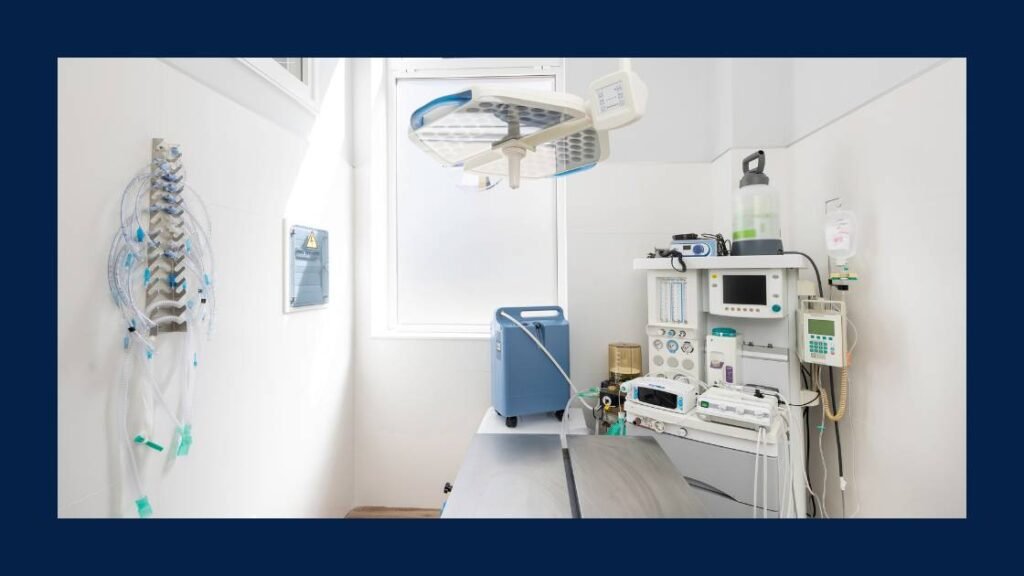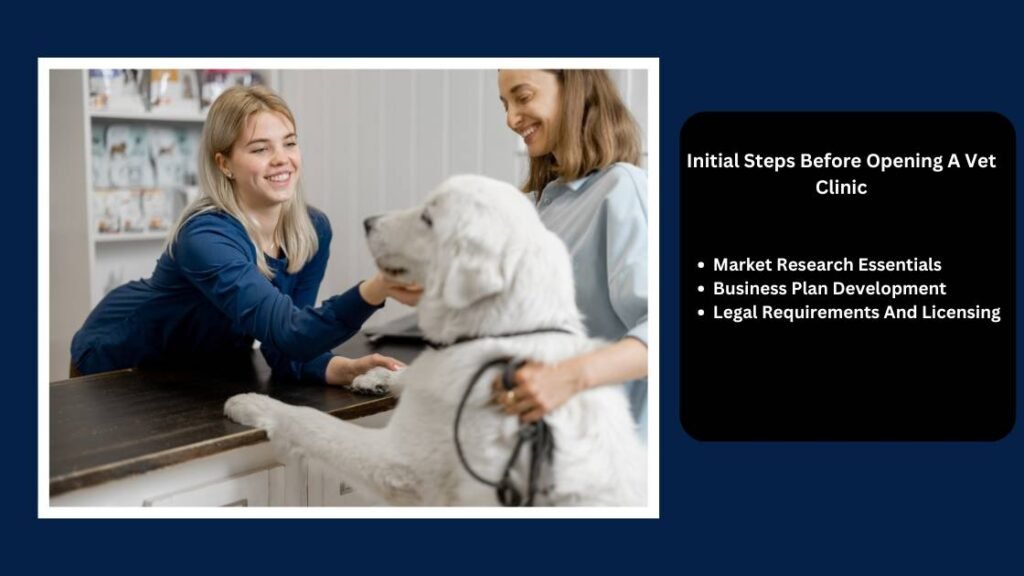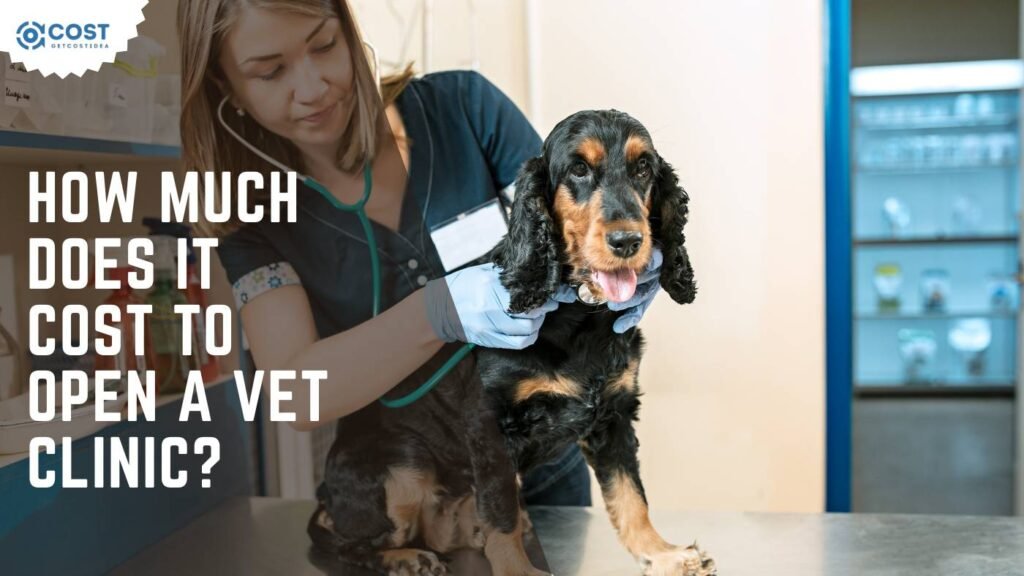Opening a vet clinic can cost between $250,000 to $1,000,000. Start-up expenses vary depending on location, services, and clinic size.
Starting a veterinary clinic is a significant but rewarding investment for veterinarians. Opening a place like this costs money for things like renting or buying the building, fixing it up, buying medical stuff, getting all the medicines and tools you need, paying for licenses, and getting computer programs to run the clinic.
If you’re thinking about opening a vet clinic, one of the first questions you might have is, “How Much Does It Cost to Open a Vet Clinic?” It’s an important consideration because the initial investment can vary widely depending on factors like location, size, and services offered.
Securing a location in a community with a high pet population can increase the clinic’s potential client base, making the investment more lucrative. Quality service and compassionate care remain crucial to building a reputable practice within the bustling pet care industry.
Aspiring veterinary entrepreneurs should also consider operational costs such as staffing, marketing, and insurance. But ultimately, to get a clear picture, you’ll need to crunch the numbers and develop a robust business plan tailored to your specific circumstances.
Introduction To Veterinary Clinic Startups

Embarking on the journey to establish a vet clinic stirs a blend of excitement and apprehension. Veterinary clinic startups often mirror the dreams of animal health professionals. Yet, they require careful navigation through the practicalities of business and finance.
The Dream Of Running A Vet Clinic
Many veterinarians harbor the dream of running their practice. A place where their medical ethos and care for animals can thrive without compromise. It’s a noble venture that promises professional autonomy and the ability to make a real difference in the lives of pets and owners alike.
Key Factors Affecting Startup Costs
- Location: Prime spots mean higher prices.
- Size: Bigger spaces increase initial investments.
- Services: Diverse offerings might require costly equipment.
- Staff: Qualified team members are vital and must be budgeted for.
- Regulations: Compliance with laws can affect your bottom line.
Starting a vet clinic involves a broad range of expenses. These range from leasing or purchasing property to acquiring state-of-the-art medical equipment. Not to forget the ongoing costs like salaries, utilities, and insurance.
Initial Steps Before Opening A Vet Clinic

Thinking of starting a vet clinic? Smart move! Pets are family, and their healthcare is key. Before you invest, understand the basics. There’s planning, legal stuff, and yes – cash. To make your vet clinic dream a reality, tackle these initial steps.
Market Research Essentials
Know your community’s needs. Strong market research paves your clinic’s success path. Here’s what to do:
- Identify pet populations by type and breed.
- Analyze local vet service offerings.
- Study future pet industry trends.
- Survey pet owners for their wishes.
Get the scoop on competitors. Your clinic must stand out!
Business Plan Development
Your blueprint for success – a solid business plan. It’s crucial!
- Outline the vision and mission of your clinic.
- Set clear, measurable goals.
- Detail financial plans, from startup costs to profit forecasts.
- Define marketing strategies to reach pet owners.
- Plan for staff recruitment and clinic operations.
A polished plan impresses lenders and investors. Your business victory depends on it.
Legal Requirements And Licensing
No shortcuts here! The law is complex. Vet clinics need licenses and permits. Do this right:
| Legal Task | Details |
|---|---|
| Register your clinic. | Choose a structure (LLC, corporation) and register. |
| Get a business license. | Apply at local or state government offices. |
| Ensure compliance. | Follow legal standards for facilities and care. |
| Secure DEA permits. | For handling controlled substances. |
| Professional licensing. | Vets must have State licenses. |
Rules differ by location. Consult a lawyer to cross every T and dot every I!
Location, Location, Location
Step into any thriving vet clinic, and it’s clear that location plays a pivotal role in success. While dreams of opening a veterinary clinic may dance in the heads of many passionate veterinarians, the reality of the cost is anchored in the importance of choosing the perfect location. The phrase ‘location, location, location’ isn’t just a real estate mantra; it’s a crucial factor in setting up a welcoming and accessible clinic for pet patients and their owners.
Choosing The Right Spot
Securing a prime location acts as the foundation for any new vet clinic. Below are key factors to consider:
- Demographics: Analyze local pet ownership statistics.
- Competition: Research nearby vet services to avoid market saturation.
- Accessibility: Find a spot easy for clients to reach with ample parking.
- Visibility: Select a location that is easy to see for potential new clients.
Investing time in research will yield a location that supports the clinic’s growth.
Lease Vs. Purchase: Cost Considerations
Deciding between leasing and buying is a significant financial fork in the road. Let’s delve into the details:
| Leasing | Purchasing |
|---|---|
|
|
Each option carries unique benefits and challenges. Begin with a detailed budget and align the decision with long-term business goals.
Facility Setup And Design
Opening a vet clinic is a thrilling venture for pet-loving entrepreneurs. A critical aspect lies in the facility setup and design. This stage lays the groundwork for a functional and welcoming environment. It also greatly influences the total cost. It is essential to plan meticulously to create a space that caters to the needs of patients, staff, and pet owners alike.
Clinic Layout And Equipment Needs

Designing the layout of your clinic is the first step. It will determine how effectively you can treat furry patients. A good layout ensures smooth workflow and safety for all. Consider these points:
- Reception area with seating and a welcome desk
- Examination rooms strategically placed for easy access
- Treatment areas with space for equipment
- A pharmacy and lab space for onsite diagnostics
- Isolation rooms for contagious diseases
- Surgical suite adhering to health regulations
- Recovery areas that are quiet and comfortable
- Storage for medical supplies and pet food
Budgeting for equipment is also vital. Some essential items include:
- Examination tables
- Surgical instruments and lighting
- Anesthesia machines
- Diagnostic imaging devices
- Laboratory equipment
- Kennels and cages for patient housing
Interior Design And Client Comfort
Interior design influences client impressions and pet anxiety levels. Focus on creating a serene environment. Use calming colors and incorporate natural light. Furnishings should be durable and easy to clean. Here’s how to enhance client comfort:
- Comfortable seating in waiting areas
- Engaging in reading materials related to pet care
- Separate zones for cats and dogs to reduce stress
- A play area for pets to relax before appointments
- Adequate signage for clear clinic navigation
- Free Wi-Fi for clients
Incorporating these elements into your clinic’s design can enhance the overall customer experience. Every design choice you make impacts your budget. Therefore, thorough planning and smart investments are keys to balancing costs and creating a welcoming clinic space.
Essential Equipment And Supplies
Opening a vet clinic is an exciting venture. Success starts with the right tools. Every clinic needs top-notch equipment and supplies. This post covers the costs of essential items. Let’s dive in and explore the necessary investments.
Medical Equipment Investments
The heart of a vet clinic is its medical equipment. Lifesaving diagnoses and treatments hinge on quality machinery.
- X-ray machines: Essential for internal imaging.
- Ultrasound units: Needed for non-invasive exams.
- Microscopes: Crucial for lab work.
- Exam tables: Hygienic, sturdy surfaces for patient care.
- Surgical instruments: High-precision tools for operations.
- Anesthesia machines: Key for pain-free procedures.
Estimates for these items vary widely. Factor in expenses ranging from $50,000 to $150,000 or more.
Office And Administrative Necessities
Beyond medical gear, a clinic must have a smooth-running office.
- Computers: They store patient records and handle appointments.
- Software: Manage daily clinic functions effectively.
- Furniture: Comfortable seating for waiting rooms and desks for staff.
- Phone system: Vital for patient communication.
- Payment processing: Tools to handle transactions smoothly.
A small clinic might budget $10,000 to $50,000 for these essentials.
| Category | Initial Investment Range |
|---|---|
| Medical Equipment | $50,000 – $150,000+ |
| Office Supplies | $10,000 – $50,000 |
Remember, these figures are a starting point. Exact costs depend on clinic size and location. Consult with suppliers for precise quotes. Careful planning ensures your clinic is set up for success!
Personnel And Staffing Costs
Personnel and Staffing Costs are a critical component of opening a vet clinic. These costs can greatly influence your clinic’s success. From hiring to training and managing salaries, staffing expenses require careful consideration and strategic planning to ensure you attract and retain top talent without overshooting your budget. Understanding these costs is key to establishing a functional and financially stable veterinary practice.
Hiring Qualified Staff
Attracting the right team starts with understanding what positions are essential:
- Veterinarians
- Veterinary Technicians
- Receptionists
- Administrative Personnel
- Cleaning and Maintenance Staff
Each role is vital in delivering quality animal care and customer service.
Costs vary by experience and location. Starting salaries for vets can range from $70,000 to $90,000, while vet techs might start at $30,000 to $50,000. Receptionists and administrative staff often begin at $25,000 to $40,000, with maintenance staff around $20,000 to $30,000.
Training And Salaries
Investing in staff training is crucial. This ensures high standards of animal care and customer service. Training encompasses:
- Initial onboardings, like facility tours and protocol overviews
- Continued education for medical advancements and technology
- Customer service workshops
Annual training budgets might range from $500 to $2,000 per employee, depending on the complexity of training.
Salaries should reflect experience, qualifications, and responsibilities. Regular reviews can help align pay with industry standards and performance levels.
Average annual raises of 1% to 5% are standard, impacting overall staffing costs. Budget wisely for these increases to retain quality staff.
Operating Expenses To Anticipate
Planning to open a vet clinic involves more than just securing the location and setting up shop. Once the doors are open, ongoing operating expenses play a vital role in keeping the practice healthy and responsive to pet owners’ needs. It’s critical to understand and budget for these costs to ensure the clinic operates smoothly without financial hiccups. Let’s dive into some of the main operating expenses every new vet clinic should anticipate: inventory and pharmaceutical costs and utility and maintenance expenses.
Inventory And Pharmaceutical Costs
Ensuring that your clinic has the necessary supplies is critical for operation. Here are the key costs:
- Medication: A well-stocked pharmacy for various treatments.
- Food: Dietary options for hospitalized animals.
- Medical Supplies: Items like syringes, bandages, and gloves.
Purchasing in bulk can lead to better rates, but remember that items expire. Software systems to track inventory are also prudent investments.
Utility And Maintenance Expenses
Rest assured, every vet clinic will incur monthly utility and maintenance expenses. Here’s what to budget for:
| Expense | Example Costs |
|---|---|
| Electricity | Lighting, medical equipment, climate control |
| Water | Sanitation and animal care needs |
| Internet | Records management, communication |
| Maintenance | Equipment service, facility upkeep |
Set aside funds for unexpected repairs and ensure regular services are done, curtailing future expenses.
Technology And Software For Modern Vet Clinics
Modern vet clinics depend on advanced technology and software. These cutting-edge tools help vets care for animals. They also manage the clinic’s daily tasks. They are essential for a successful practice.
Practice Management Software
Practice management software is the heart of a modern clinic. It helps with:
- Scheduling appointments
- Tracking patient records
- Managing billing and payments
- Inventory control
The cost of this software varies. Some cost $200 to $500 per month. Others might have a higher setup fee. It usually includes training and support.
Digital Record Keeping
Switching to digital record-keeping is a smart move. It makes storing and finding patient info easy. It also keeps records safe and secure. Vet clinics must have this system.
| Features | Benefits |
|---|---|
| Cloud-based storage | Access records from anywhere |
| Automated backups | Protect against data loss |
Prices range from $75 to $250 per month. Some providers offer custom pricing.
Marketing And Advertising
Stepping into the veterinary industry with your own clinic is an exciting venture. Understanding the costs for marketing and advertising is crucial. These efforts spread the word about your services. They attract pet owners and build trust. Let’s dive into creating a marketing plan and leveraging online strategies for your vet clinic.
Developing A Marketing Plan
Creating a marketing plan defines the roadmap for your clinic’s growth. It includes:
- Target Audience: Identifying pet owners in need of your services.
- Budgeting: Allocating funds for various marketing channels.
- Goals: Setting clear objectives for what you want to achieve.
A detailed table can help with cost estimates:
| Marketing Activity | Estimated Cost |
|---|---|
| Branding (logo, business cards) | $500 – $2000 |
| Website Development | $1000 – $5000 |
| Printed Materials (flyers, brochures) | $200 – $1000 |
| Advertising (local media, online ads) | $300 – $1000/month |
Online Presence And Social Media Strategies
Building an online presence is key to success in today’s digital world. Include:
- A user-friendly website that showcases services and allows appointments.
- SEO strategies that make your website visible to potential clients.
- Social media engagement to connect with pet owners and share useful content.
Invest in these approaches for better reach:
- Google Ads for targeted advertising.
- Facebook and Instagram Ads for visual appeal.
- Email newsletters to keep clients informed.
Expect to spend around $500 – $1500/month on these strategies. The cost varies based on your chosen platforms and reach.
Insurance, Risks, And Unexpected Costs
Opening a vet clinic is an exciting venture. But, along with excitement comes responsibility. One must take into account various financial risks. Insurance is a crucial factor to consider. It covers unexpected events that could otherwise cripple a new business. Risks are part of starting a clinic. You must prepare for them. The cost of opening a vet clinic involves more than just equipment and property. Unforeseen costs can arise. Being ready with a risk management plan is essential.
Types Of Insurance Coverage
- General Liability Insurance: This shields your business from common claims. It handles accidents, injuries, and claims of negligence.
- Professional Liability Insurance: Also known as malpractice insurance. It covers claims arising from professional services.
- Property Insurance: This insurance protects your clinic’s physical assets. It will help in case of fire, theft, or natural disasters.
- Workers’ Compensation: If you have employees, this is mandatory. It assists employees hurt on the job.
- Business Interruption Insurance: This helps if you must stop operations unexpectedly. It can cover lost income or additional operating expenses.
Each type of insurance has its importance. You should not ignore any. Vet clinic owners often tailor their insurance packages. This ensures all potential risks have coverage. Make sure to research and choose the best insurance package for your clinic.
Planning For Contingencies
Preparing for unexpected situations is a must. Financial setbacks can occur at any time. Creating a contingency fund is a smart move. This fund is your financial safety net.
- Set aside a portion of initial capital just for emergencies.
- Regularly contribute a small percentage of profits to this fund.
- Have a detailed risk management plan. It should outline steps for different emergency scenarios.
Contingency planning stabilizes your clinic during tough times. It ensures you have the funds to handle whatever comes your way. Whether it’s an equipment malfunction or a legal issue, you’re ready.
All these considerations — insurance, risks, and backup plans, together influence the overall cost of opening a vet clinic. They are as crucial to your clinic’s success as the medical services you offer. Proper planning in these areas can safeguard your dream of running a vet clinic and guide it towards long-term success.
Financial Planning And Assistance

Embarking on the adventure of opening a vet clinic brings numerous financial considerations to the table. From securing funds for initial startup costs to covering ongoing expenses, navigating the financial landscape is decisive for success. Adequate financial planning and assistance are paramount in turning your veterinary practice dream into reality.
Financing Options For New Clinics
Exploring financing options is a critical step for budding veterinary clinic owners. Various paths are available, suited to different needs and circumstances.
- Traditional Bank Loans: Banks offer tailored loans for business startups, often with competitive interest rates.
- Small Business Administration (SBA) Loans: These government-backed loans provide support for small businesses with potentially lower down payments and favorable terms.
- Equipment Financing: Specific loans exist for purchasing necessary clinic equipment, spreading the cost over its usable life.
- Alternative Lenders: Online lenders may offer faster approval times and flexible conditions, ideal for those requiring quick funding.
Grants And Subsidies For Veterinary Services
Non-repayable financial aid can come in the form of grants and subsidies for veterinary clinics. They provide a significant lift, especially in underserved communities or for specialized services.
| Source | Type of Aid | Purpose |
|---|---|---|
| Government Grants | Non-repayable | Support vet practices in rural or high-need areas |
| Private Foundations | Non-repayable | Foster innovation in veterinary medicine |
| Industry Partnerships | Subsidies or In-Kind Support | Advanced veterinary research and services |
Research is key, as many of these programs have specific requirements and deadlines for application. It’s essential to stay informed about these opportunities to leverage the support they offer.
A Realistic Look At A Vet Clinic’s Profitability

Starting a vet clinic is an exciting venture for animal lovers with a passion for veterinary science. But, behind the love for pets lies a critical financial landscape. This section takes a deep dive into what makes a vet clinic profitable.
Break-even Analysis
Understanding when your clinic can start making money is essential. A break-even analysis pinpoints this moment.
- Fixed costs such as rent, salaries, and utilities are constants.
- Variable costs fluctuate with the number of patients.
- Revenue per service, from consultations to surgeries, adds to your gains.
| Monthly Costs | Amount |
|---|---|
| Fixed Costs | $5000 |
| Variable Costs | $2000 |
| Total Revenue Needed | $7000 |
To break even, your clinic must earn at least $7000 monthly.
Long-term Financial Projections
Forecasting for the future is about thinking long-term. Vet clinics have their unique growth patterns.
- Year 1 involves income stabilization.
- Year 2 might see a steady increase in clientele.
- Year 3 and beyond could lead to expansion and higher profits.
Key factors include market trends, competition, and service quality.
Is Opening A Vet Clinic Worth It?
Investing in a veterinary clinic is a significant decision. Understanding the costs involved helps make it clearer. Let’s look at the long-term benefits versus the initial investment.
Weighing The Investment Against The Reward
The cost of launching a vet clinic can be steep. Expect upfront expenses for equipment, real estate, and staff. Running costs for supplies, utilities, and insurance are ongoing.
But rewards can be great – both financially and emotionally. Successful clinics see a steady income from services and treatments. Helping animals and providing service brings emotional satisfaction.
- Budget carefully for startup costs.
- Plan for ongoing expenses.
- Analyze the market to forecast income potentials.
It’s a balance, but one that can tip favorably for determined veterinarians.
Final Tips For Aspiring Vet Clinic Owners
Before diving in, consider some final advice. Prepare a thorough business plan. Get to know your market and the competition. Research animal healthcare trends.
Networking is key. Develop relationships with other vets, pet owners, and suppliers. Invest in quality equipment and staff training. The right decisions early on lay a foundation for success.
- Create a solid business plan.
- Understand market needs.
- Build a reliable network.
- Don’t skimp on quality.
Starting a vet clinic can be a rewarding endeavor. It takes passion, dedication, and smart planning.
Frequently Asked Questions for How Much Does It Cost to Open a Vet Clinic
How Profitable Are Vet Clinics?
Vet clinics can be profitable businesses with varying profit margins, often influenced by services offered, location, and effective management. On average, successful clinics may see profit margins between 10-20%.
Who Owns Most Vet Clinics?
Most veterinary clinics are independently owned by veterinarians, but corporate entities like Mars, Inc. own a significant number of practices.
What Is One Of The Largest Expenses For Veterinary Practice?
One of the largest expenses for a veterinary practice is personnel costs, including salaries for veterinarians and support staff.
How To Start A New Vet Practice?
Research local market needs and secure financing. Obtain necessary licenses and permits. Choose a suitable location and set up your clinic. Invest in the necessary equipment and hire qualified staff. Market your practice to attract clients.
Conclusion
Opening a vet clinic is an investment in both your financial future and animal welfare. Costs will vary, influenced by location, services, and facility size. Careful budgeting and planning pave the way for a successful launch. Now, empower your veterinary dream with calculated steps toward creating a haven for pets in need.


